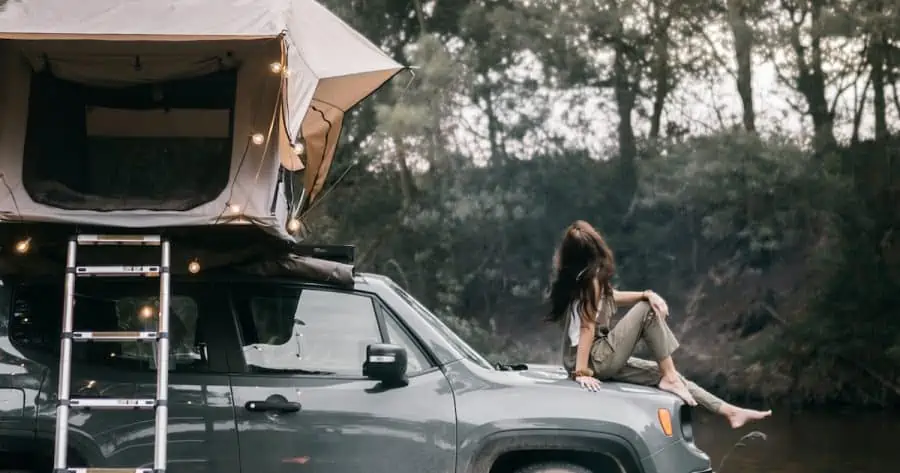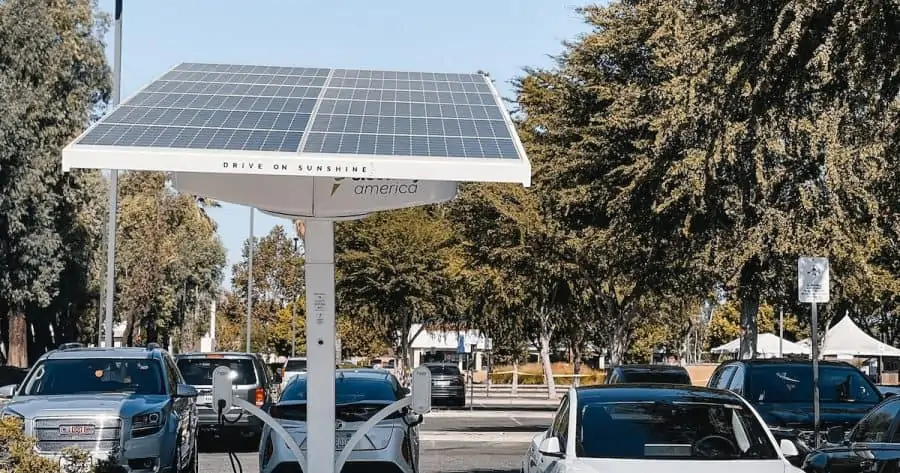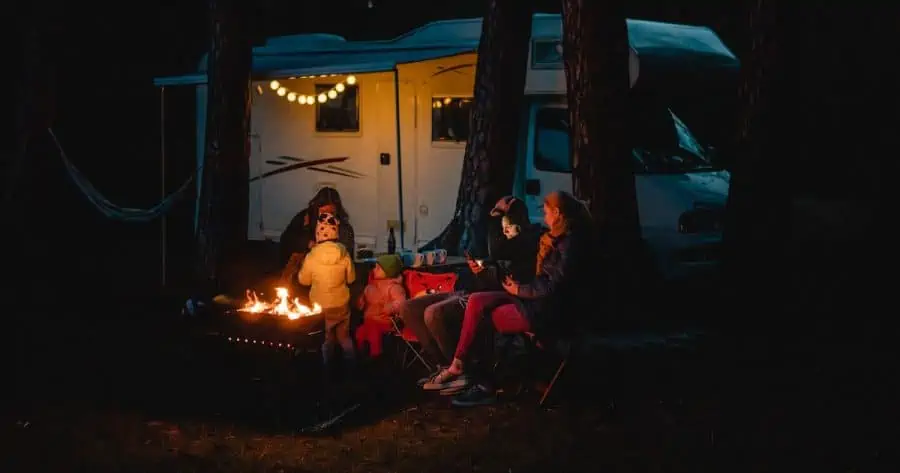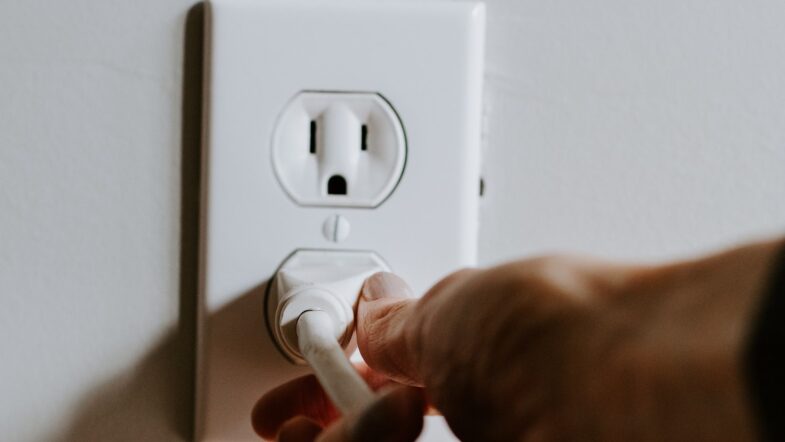To power all the equipment with electricity, a generator is sometimes employed. It is, without doubt, the choice of many RVers. Even on costly models, its drawback is that it generates a lot of noise.
As an alternative to using generators, you can use the car’s battery. Portable power stations are also a great idea. The last option is using solar, which is great but not always practical, as you will see below.
Before diving deeper into these alternatives, let’s first understand the RV system.

Contents
AC Vs DC: What Are They?
Two electrical RV systems are present in most of the rigs. There is an AC (alternating current) system that is comparable to the one in a conventional household. A DC (direct current) system that functions like the one found in an automobile is also available.
The DC system is fueled by one or maybe more battery packs placed in your RV, while the AC system is fueled by hooking your RV into an outside AC power source. The AC power system runs large equipment like the oven, air conditioner, and electrical outlets.
The DC power system runs your home’s ventilation, television, radio, lighting, and water pump. The DC system, which is constrained by your RV batteries, is unable to provide as much power as the AC system can.
The two RV electrical systems are interconnected, so if you plug your RV into AC power, the batteries in the DC system will be charged. The tool that does this is known as a converter. Many RVs also include an inverter, which converts DC electricity into AC power, and the RV power converter. The wall outlets on RVs with inverters will be clearly labeled and run on the DC battery system while providing AC electricity.
The majority of RVs are designed such that you can operate almost all of their systems when you have RV shore power. If you do not have any shore power, you must rely on the DC system, which may last a few days while still powering necessities like the water pump and lights.
In other words, you are free to relax and revel in all the luxuries of the home if you’re hooked into a power source. However, if you’re using a battery, such as while boondocking, stick to the essentials and use it wisely.
3 Ways To Power RV Without Generator
Keep reading below as we take you to three of the most common ways you can charge your RV without a generator.
Charge Utilizing The Car’s Battery
You may use your engine’s power whether you’re towing a trailer, RV, or van. There are three methods to use your car’s power:
While your car is running, connect a 12-volt inverter to the cigarette lighter to recharge your electronics. Most of these gadgets feature several outlets for charging 110 AC devices (such as your computer) and USB-powered devices (such as your mobile).
Use cables to attach an inverter straight to your vehicle’s batteries (peak). This gadget comes in handy when you suddenly require a lot of electricity. The only restriction is that, in most cases, you must keep your engine running in order to prevent your battery from dying.
Install a continuous-duty solenoid in your trailer to charge a home battery with the additional power your alternator produces while driving. A solenoid’s brilliance is that it automatically fills your home batteries (coach batteries in a motorhome or standalone batteries in a camper) while driving.
If you’re experienced enough, you can set one up manually. Or else a mechanic or RV can assist you.

Utilize Portable Power Stations
When boondocking, power stations are excellent for powering a variety of electronics. They are easy-to-use, all-in-one rechargeable batteries that include an inverter and charge controller. As a result, they may be used much like a wall outlet to charge various electronic devices, which often have USB and DC connectors. There are many different sizes and purposes for portable power stations.
You must use a solar panel or a wall socket to charge your power station while driving. The amount of time it takes to charge them and how long the power lasts depends on the size of the appliances you need to charge. Additionally, internal batteries might differ across brands, including lithium-ion and lead acid AGM.
Since lithium-ion is regarded as the finest, it will cost more. If you have a strategy for keeping them charged, power stations may be used to deliver a consistent source of electricity without being hooked up.
Recharge With Solar
The four basic parts you need to install a solar system on your RV are listed below as follows:
- solar cells
- a charge controller to adjust the panel’s input voltage
- a device that converts amps to watts so that you may charge things
- a battery to keep the energy you gather
Depending on what you need to power, you will require a certain number of panels and batteries. One 100-watt panel and one 100-amp-hour battery are sufficient for some nomads to charge their phones, computers, and maybe even a vehicle vacuum.
There are also nomads who keep a battery bank with six 100-amp hour lithium batteries and 1,000 watts of solar panels mounted on the roof of their RV.
The amount you would require will depend on your personal camping preferences. You may use similar Power Station Comparisons, which show the typical energy use of various appliances, as a calculator to determine how much power you’ll need. If you’re still unsure, see a solar professional, check over your power requirements, and design your own setup.
The handy combination of solar and portable power stations can successfully power several gadgets. You can use the solar to keep the batteries in your house, and the power plant charged. The batteries are powered by the sun during the day and by power plants at night.
Here’s a useful video about solar powering your RV:
Solar Suitcase vs. Mounted Panels
A solar suitcase could be a decent alternative to take into consideration if you just require a little quantity of solar power, such as 100 watts. The advantage of using a suitcase or a panel that isn’t attached is that you can direct the panel toward the sun as it travels across the sky to provide the most efficient charging.
The drawback is that in order for it to work, it needs to be regularly shifted, loaded, and unloaded in a tiny space.
Mounted panels are required for a more robust solar setup. The only restrictions on how many panels may be put on your rig’s roof are space availability and expense. The amount of electricity you can generate automatically from the sun is virtually limitless if you have the resources and the space.
To charge your home or coach batteries, Mounted Panels must be fitted correctly, but once they are, there is no mess, no worry, and electricity will stream to your trailer just like it would into a house, given that they have access to sunlight.
The drawback of adding solar panels is that to obtain a good charge; you must park your car in the sunlight, which can keep your trailer warmer during the summer. If you don’t have your batteries put on a structure that leans to maximize exposure to direct sunlight throughout the winter when the sun is at a different angle, charging your batteries may take more time.
Should You Use A Generator?
One technique to produce power is with a generator. The two categories of generators are portable and on-board.
Powered by gasoline, portable generators generate power. Depending on how much power you need to operate and recharge your devices, they come in a variety of sizes. Some are large and heavy, and they often include wheels so they can be moved.
It is recommended only to operate portable generators outside where there is enough airflow. As a result, moving and setting up portable generators is necessary for safe operation.
Onboard, built-in generators are a common feature of RVs. The propane tank or engine fuel serves as the onboard generator’s fuel supply. This kind of generator works well to recharge your vehicle’s batteries quickly.
Even solar-powered nomads occasionally need to add to their battery charge on overcast days. They are also excellent for powering devices like a blowdryer, blender, or Instant Pot that are far too power-hungry even for your inverter to manage.
Some nomads use a generator instead of solar energy or a campsite hookup to fuel their batteries. This has the obvious drawback that most people don’t enjoy the sound or odor of a generator operating the whole day.
Most campsites and RV parks have quiet times between 10 p.m. and 7 a.m., during which a generator cannot be used. However, it is a powerhouse for electricity, and most nomads traveling in RVs see it as a necessary source of power (even if just as a backup to other power sources).
What Sort Of Electrical Hookup Is Required For An RV?

Although it is significantly larger, an RV’s conventional electrical hookup resembles domestic electrical outlets. You’ll probably require a 30- or 50-amp electrical connection for your RV to operate at its maximum potential.
Nevertheless, you can connect an RV to a typical 120-volt home outlet with the right adapters and some power management. In order to avoid overloading an outlet or power cable, you must control your power properly.
Pulling far too much electricity might cause heat to be produced, raising the possibility of a fire. When recharging your RV, be aware of the limitations of your power lines and any available outlets.
How To Hook Up Power To A Camper
You must carry out the procedures in a precise sequence if you want to power up an RV. Failure to do so may put you at risk and harm your RV.
1. Disable The Breaker
Turning off the breaker at the power pedestal is the first step in connecting your RV’s electrical system to the electric grid. After you shut off the breaker, check the power pedestal, particularly if it appears iffy.
You can never tell how the former campers treated the electricity pedestals; some campsites maintain them nicer than others. If there are any evident indications of damage or safety concerns, alert the campsite personnel or the camp host.
2. Examine The Power Source
You must attach a surge protector or energy management system after making sure everything is working. When connecting their RV to power, many RVers make the error of not employing these safety measures. However, these tools can check the wiring and shield your RV’s electrical connection from voltage spikes and dips.
After plugging in your gadget, open the outlet’s breaker. In the event that there are any connection problems, such devices frequently employ color- or numeric-coded codes. Switch the breaker back off when the test is finished.
Each time you connect your RV to a power source, you must test it beforehand. A single tester can also be used to test the power source.

3. Attach The RV’s Power Cable And Surge Protector
You can now reach for your power cable if your safety gadgets don’t provide any alarms or cautions. Start by attaching the correct end of your power line to your RV. These are frequently twist-and-lock connectors that tightly link the power line to the RV.
Grab your power cord’s plug-in end and insert it into your EMS or surge protector. Afterward, you may plug it directly into the power pedestal’s outlet. Make sure all of your connections are solid and fully pushed in.
4. Turn On The Power
The breaker must be turned on as the last step to supply power to your RV. Make absolutely sure everything goes according to plan before flipping the switch. Before continuing to set up the remainder of your campground, inspect your surge protector and EMS to make absolutely sure there are no alarms or problems.
Final Thoughts
Although using a generator to power your RV is a fantastic alternative, there are some disadvantages, such as those loud, obtrusive noises. We covered the four main techniques in this post to power your RV without a generator.
